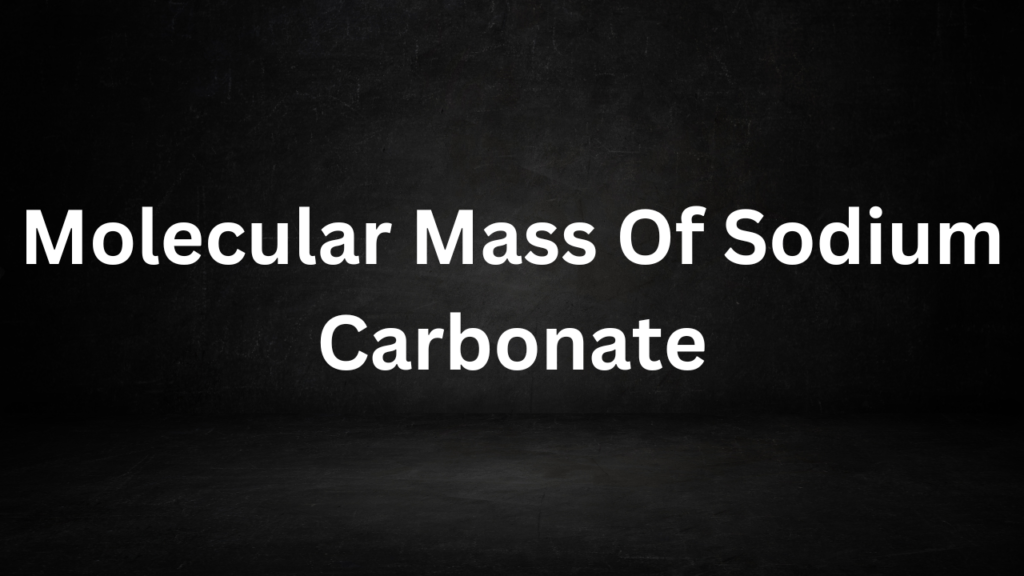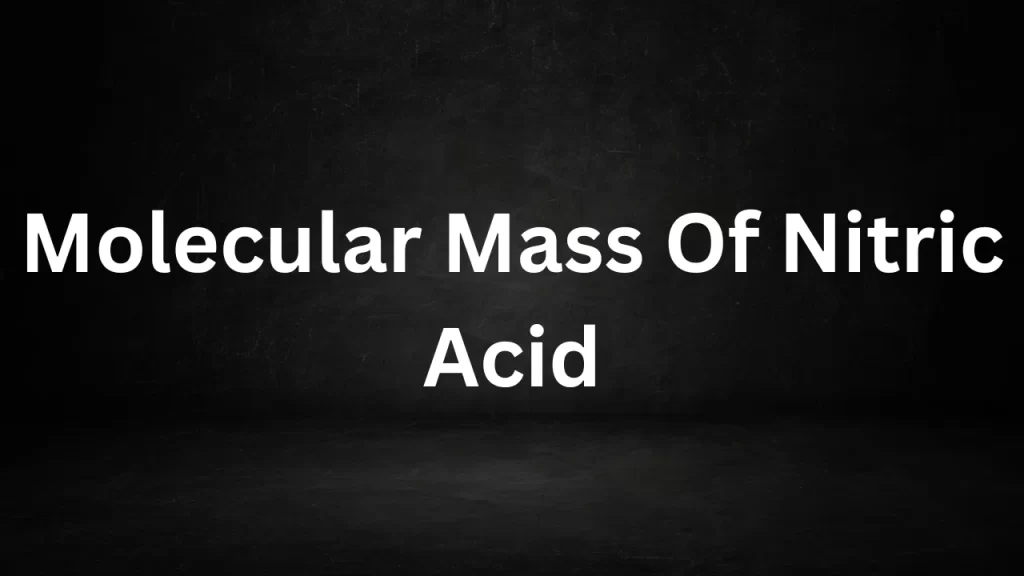Blog
Benzoic Acid Molar Mass
Benzoic Acid Molar Mass: Benzoic acid (C7H6O2) is a well-known and widely used organic compound with various applications in the food industry, pharmaceuticals, and chemical synthesis.
In the field of chemistry, understanding the mol mass of benzoic acid is essential, as it serves as a foundational concept for various calculations and chemical reactions. In this article, we will delve into the concept of mol mass, explore its significance in chemistry, and calculate the mol mass of benzoic acid.

Benzoic Acid Molar Mass
Molar Mass: A Key Concept
Molar mass, also known as molecular weight, is a fundamental concept in chemistry. It represents the mass of one mole of a substance and is typically expressed in atomic mass units (amu) or unified atomic mass units (u). Calculating the molar mass of a compound involves summing the atomic masses of all the constituent atoms in its chemical formula while considering their respective proportions.
Calculating the Molar Mass of Benzoic Acid
To calculate the mol mass of benzoic acid (C7H6O2), we must determine the atomic masses of the elements: carbon (C), hydrogen (H), and oxygen (O), and then apply these values to the chemical formula.
- Carbon (C): The atomic mass of carbon is approximately 12.01 amu.
- Hydrogen (H): The atomic mass of hydrogen is approximately 1.01 amu.
- Oxygen (O): The atomic mass of oxygen is approximately 16.00 amu.
Now, let’s calculate the molar mass of benzoic acid:
Molar Mass of C7H6O2 = (7 × Atomic Mass of C) + (6 × Atomic Mass of H) + (2 × Atomic Mass of O)
Molar Mass of C7H6O2 = (7 × 12.01 amu) + (6 × 1.01 amu) + (2 × 16.00 amu)
The Molar Mass of C7H6O2 = 84.07 amu + 6.06 amu + 32.00 amu
Molar Mass of C7H6O2 = 122.13 amu
So, the mol mass of benzoic acid (C7H6O2) is approximately 122.13 amu.
Significance of Benzoic Acid Molar Mass
The mol mass of benzoic acid holds significant importance in various aspects of chemistry:
- Stoichiometry: Molar mass is crucial in stoichiometry, allowing chemists to balance chemical equations and determine the quantities of reactants and products involved in chemical reactions with benzoic acid.
- Solution Preparation: In laboratories and industries, knowledge of the molar mass is essential for accurately preparing benzoic acid solutions with specific concentrations, ensuring precise measurements.
- Pharmaceuticals and Food Industry: Benzoic acid is used as a preservative in pharmaceuticals and the food industry. Its molar mass is important for quality control and regulatory compliance.
- Chemical Synthesis: In chemical synthesis, the mol mass of benzoic acid aids in calculating reactant quantities and product yields, contributing to the efficiency of chemical processes.
- Analytical Chemistry: Analytical techniques often rely on mol mass measurements to identify and quantify substances, making it a critical parameter in analytical chemistry.
Conclusion
The mol mass of benzoic acid (C7H6O2) is a fundamental concept in chemistry, with practical implications in various applications. Calculating its mol mass empowers informed decisions, precise experiments, and efficient benzoic acid utilization in chemistry, pharmaceuticals, and food. This knowledge underscores the significance of mol mass as a cornerstone of chemistry, enabling us to better understand and manipulate the properties of compounds like benzoic acid in a wide range of scientific and industrial endeavors.
Read More
- Sulfuric Acid Molar Mass
- Discrete Mathematics For Computer Science
- Molecular Mass of Carbon Dioxide
- Difference Between Conduction Convection And Radiation
- Excretory System Class 10
Frequently Asked Questions (FAQs) Benzoic Acid Molar Mass
1. What is the molar mass of benzoic acid (C7H6O2)?
The mol mass of benzoic acid (C7H6O2) is approximately 122.13 atomic mass units (amu) or unified atomic mass units (u).
2. What is molar mass, and why is it important in chemistry?
Molar mass, also known as molecular weight, represents the mass of one mole of a substance and is expressed in atomic mass units (amu) or unified atomic mass units (u). It is crucial in chemistry for stoichiometry, balancing chemical equations, and various other calculations.
3. How is the molar mass of benzoic acid calculated?
To calculate the mol mass of benzoic acid, you sum the atomic masses of all its constituent atoms (carbon, hydrogen, and oxygen) according to their proportions in the chemical formula.
4. What are the atomic masses of the elements in benzoic acid (C7H6O2)?
The approximate atomic masses are:
- Carbon (C): 12.01 amu
- Hydrogen (H): 1.01 amu
- Oxygen (O): 16.00 amu
5. Why is the molar mass of benzoic acid significant in chemistry?
The mol mass of benzoic acid is vital for stoichiometry, allowing chemists to balance chemical equations and determine reactant and product quantities accurately. It also plays a role in solution preparation and analytical chemistry.
Sulfuric Acid Molar Mass
Sulfuric Acid Molar Mass: Sulfuric acid (H2SO4) is one of the most important and widely used chemicals in various industrial applications. It serves as a cornerstone in chemical manufacturing,
petroleum refining, and countless laboratory experiments. In the realm of chemistry, understanding the molar mass of sulfuric acid is fundamental, as it plays a pivotal role in stoichiometry, chemical reactions, and laboratory practices. In this article, we will delve into the concept of molar mass, explore its importance in chemistry, and calculate the molar mass of sulfuric acid (H2SO4).

Sulfuric Acid Molar Mass
Molar Mass: An Essential Concept
Molar mass, also known as molecular weight, is a fundamental concept in chemistry. It represents the mass of one mole of a substance and is typically expressed in atomic mass units (amu) or unified atomic mass units (u). Calculating the mol mass of a compound involves summing the atomic masses of all the constituent atoms in its chemical formula, taking into account their respective proportions.
Calculating the Molar Mass of Sulfuric Acid
To calculate the mol mass of sulfuric acid (H2SO4), we must determine the atomic masses of the elements: hydrogen (H), sulfur (S), and oxygen (O), and then apply these values to the chemical formula.
- Hydrogen (H): The atomic mass of hydrogen is approximately 1.01 amu.
- Sulfur (S): The atomic mass of sulfur is approximately 32.07 amu.
- Oxygen (O): The atomic mass of oxygen is approximately 16.00 amu.
Now, let’s calculate the mol mass of sulfuric acid:
Molar Mass of H2SO4 = (2 × Atomic Mass of H) + (1 × Atomic Mass of S) + (4 × Atomic Mass of O)
The Molar Mass of H2SO4 = (2 × 1.01 amu) + (1 × 32.07 amu) + (4 × 16.00 amu)
Molar Mass of H2SO4 = 2.02 amu + 32.07 amu + 64.00 amu Molar Mass of H2SO4 = 98.09 amu
So, the mol mass of sulfuric acid (H2SO4) is approximately 98.09 amu.
Significance of Sulfuric Acid Molar Mass
The mol mass of sulfuric acid holds significant importance in various aspects of chemistry:
- Stoichiometry: Molar mass is essential in stoichiometry, helping chemists balance chemical equations and determine the quantities of reactants and products involved in chemical reactions with sulfuric acid.
- Laboratory Practices: In laboratories, knowledge of the mol mass is vital for accurately preparing sulfuric acid solutions with specific concentrations, ensuring precise measurements.
- Industrial Applications: Sulfuric acid is a key component in various industrial processes, including fertilizers, petroleum refining, and chemical manufacturing. Understanding its mol mass is crucial for quality control and process optimization.
- Safety: Knowing the mol mass of sulfuric acid is essential for handling it safely, particularly in industrial and laboratory settings, as it assists in determining appropriate safety protocols and precautions.
Conclusion
The mol mass of sulfuric acid (H2SO4) is a fundamental concept in chemistry, with practical implications in various applications. By calculating its mol mass, chemists can make informed decisions, conduct accurate experiments, and ensure the efficient utilization of sulfuric acid in chemical processes and industries. This knowledge underscores the significance of mol mass as a cornerstone of chemistry, enabling us to harness the power of compounds like sulfuric acid in a multitude of scientific and industrial endeavors.
Read More
- Discrete Mathematics For Computer Science
- Molecular Mass of Carbon Dioxide
- Difference Between Conduction Convection And Radiation
- Excretory System Class 10
- Sodium Carbonate Molar Mass
Frequently Asksed Questions (FAQs) On Sulfuric Acid Molar Mass
1. What is the molar mass of sulfuric acid (H2SO4)?
The mol mass of sulfuric acid is approximately 98.09 atomic mass units (amu) or unified atomic mass units (u).
2. What is molar mass, and why is it important in chemistry?
Molar mass, also known as molecular weight, is the mass of one mol of a substance and is expressed in amu or u. It is crucial in chemistry for stoichiometry, determining quantities in reactions, and solution preparations.
3. How is the molar mass of sulfuric acid calculated?
To calculate the mol mass of sulfuric acid (H2SO4), you sum the atomic masses of all its constituent atoms (hydrogen, sulfur, and oxygen) according to their proportions in the chemical formula.
4. What are the atomic masses of the elements in sulfuric acid?
The approximate atomic masses are:
- Hydrogen (H): 1.01 amu
- Sulfur (S): 32.07 amu
- Oxygen (O): 16.00 amu
5. What are some applications of sulfuric acid in chemistry and industry?
Sulfuric acid is used in various industries, including fertilizers, petroleum refining, chemical manufacturing, and batteries. It is also a common reagent in laboratories.
Molecular Mass Of Sodium Carbonate
Molecular Mass Of Sodium Carbonate: Sodium carbonate, also known as soda ash or washing soda, is a versatile chemical compound with numerous applications, ranging from household cleaning to industrial processes.
In the field of chemistry, understanding the mole mass of sodium carbonate plays a pivotal role in various calculations, especially those related to chemical reactions, stoichiometry, and solution preparations. In this article, we’ll explore molar mass, its significance in chemistry, and calculate the molar mass of sodium carbonate (Na2CO3).

Molecular Mass Of Sodium Carbonate
Molecular Mass: A Foundational Concept
The Molecular mass, also referred to as mole weight or molar mass, is a fundamental concept in chemistry. It denotes the mass of a single mole of a substance, commonly expressed in atomic mass units (amu) or unified atomic mass units (u). To calculate the molar mass of a compound, add the atomic masses of all its constituent atoms, considering their relative proportions.
Calculating the Molecular Mass of Sodium Carbonate
To calculate the mole mass of sodium carbonate (Na2CO3), we must first determine the atomic masses of the elements: sodium (Na), carbon (C), and oxygen (O), and then apply these values to the chemical formula.
- Sodium (Na): The atomic mass of sodium is approximately 22.99 amu.
- Carbon (C): The atomic mass of carbon is approximately 12.01 amu.
- Oxygen (O): The atomic mass of oxygen is approximately 16.00 amu.
Now, let’s calculate the molecular mass of sodium carbonate:
Molecular Mass of Na2CO3 = (2 × Atomic Mass of Na) + (1 × Atomic Mass of C) + (3 × Atomic Mass of O)
The Molecular Mass of Na2CO3 = (2 × 22.99 amu) + (1 × 12.01 amu) + (3 × 16.00 amu)
Molecular Mass of Na2CO3 = 45.98 amu + 12.01 amu + 48.00 amu
Molecular Mass of Na2CO3 = 105.99 amu
So, the molecular mass of sodium carbonate (Na2CO3) is approximately 105.99 amu.
Significance of Molecular Mass of Sodium Carbonate
The mole mass of sodium carbonate holds significant importance in various aspects of chemistry:
- Stoichiometry: Mole mass is crucial in stoichiometry, allowing chemists to balance chemical equations and determine the quantities of reactants and products involved in chemical reactions with sodium carbonate.
- Solution Preparation: In laboratories and industries, knowledge of the mole mass is essential for accurately preparing sodium carbonate solutions with specific concentrations, ensuring precise measurements.
- Industrial Applications: Sodium carbonate is widely used in industries such as glass manufacturing, detergents, and water treatment. Understanding its mole mass is vital for quality control and process optimization.
- Household Uses: Sodium carbonate is commonly found in household cleaning products, and its mole mass can help consumers understand product concentrations and efficacy.
- Safety: Knowing the mole mass of sodium carbonate is essential for handling it safely, especially in industrial and laboratory settings, as it assists in determining appropriate safety protocols and precautions.
Conclusion
The mole mass of sodium carbonate (Na2CO3) is a fundamental concept in chemistry, holding practical importance in various applications. Finding molar mass empowers informed choices, precise experiments, and optimized sodium carbonate use in various contexts. Comprehending this essential parameter amplifies our capacity to utilize sodium carbonate’s versatility across diverse chemical processes and applications.
Read More
- Molecular Mass Of Nitric Acid
- Molecular Mass Of Sulphuric Acid
- Molar Mass Of Sulphuric Acid
- Types Of Motion In Physics
- Kinetic Energy Class 9
Frequently Asked Questions (FAQs) On Molecular Mass Of Sodium Carbonate
1. What is the molecular formula of sodium carbonate?
The mole formula of sodium carbonate is Na2CO3, representing two sodium atoms (Na), one carbon atom (C), and three oxygen atoms (O) in a single molecule.
2. What does molecular mass or molar mass mean in chemistry?
Molecular mass, also known as molar mass, refers to the mass of one mole of a substance and is typically expressed in atomic mass units (amu) or unified atomic mass units (u). It is a fundamental concept in chemistry used for various calculations.
3. Why is the molecular mass of sodium carbonate important in chemistry?
The mole mass of sodium carbonate is essential in chemistry because it helps determine the quantity of sodium carbonate involved in chemical reactions, stoichiometry, and solution preparations.
4. How is the molecular mass of sodium carbonate calculated?
To calculate the mole mass of sodium carbonate (Na2CO3), you sum the atomic masses of all the atoms in its chemical formula, taking into account their respective proportions.
5. What is the molecular mass of sodium carbonate (Na2CO3)?
The mole mass of sodium carbonate is approximately 105.99 amu.
Molecular Mass Of Nitric Acid
Molecular Mass Of Nitric Acid: Nitric acid (HNO3) is a highly corrosive and essential chemical compound used in various industrial applications, including the production of fertilizers, explosives, and cleaning agents.
Understanding nitric acid’s molar mass is crucial in chemistry, impacting stoichiometry, reactions, and laboratory procedures significantly. This article delves into molecular mass, its significance in chemistry, and the calculation of nitric acid’s (HNO3) molecular mass.
Molecular Mass Of Nitric Acid
Molecular Mass: A Fundamental Concept
The Molecular mass, also known as mole weight or molar mass, is a fundamental concept in chemistry. It represents the mass of one mole of a substance and is expressed in atomic mass units (amu) or unified atomic mass units (u). The molecular mass of a compound is calculated by summing the atomic masses of all the atoms in its chemical formula, considering the number of atoms of each element.
Calculating the Molecular Mass of Nitric Acid
To find the molecular mass of nitric acid (HNO3), we sum the atomic masses of hydrogen (H), nitrogen (N), and oxygen (O) within the chemical formula.
- Hydrogen (H): The atomic mass of hydrogen is approximately 1.01 amu.
- Nitrogen (N): The atomic mass of nitrogen is approximately 14.01 amu.
- Oxygen (O): The atomic mass of oxygen is approximately 16.00 amu.
Now, let’s calculate the mole mass of nitric acid:
Molecular Mass of HNO3 = (1 × Atomic Mass of H) + (1 × Atomic Mass of N) + (3 × Atomic Mass of O) Molecular Mass of HNO3 = (1 × 1.01 amu) + (1 × 14.01 amu) + (3 × 16.00 amu) Molecular Mass of HNO3 = 1.01 amu + 14.01 amu + 48.00 amu Molecular Mass of HNO3 = 63.02 amu
So, the mole mass of nitric acid (HNO3) is approximately 63.02 amu.
Significance of Molecular Mass of Nitric Acid
The mole mass of nitric acid is significant for several reasons:Stoichiometry:
- It is crucial in stoichiometry, helping chemists balance chemical equations and calculate the amount of reactants and products involved in chemical reactions involving nitric acid.
- Laboratory Work: In laboratories, scientists use the mole mass to measure and prepare solutions of nitric acid with specific concentrations for experiments and analyses.
- Industrial Applications: Industries rely on the mole mass to ensure precise measurements and control processes involving nitric acid, such as in the production of fertilizers, explosives, and chemical manufacturing.
- Safety Precautions: Understanding the mole mass is essential for handling nitric acid safely, as it helps in determining appropriate safety measures and precautions due to its corrosive nature.
Conclusion
The molar mass of nitric acid (HNO3) is a fundamental concept in chemistry, with essential roles in labs and industries. Calculating molecular mass aids chemists in understanding nitric acid’s behavior and composition, ensuring precise control in chemistry and industry.
Read More
- Molecular Mass Of Sulphuric Acid
- Molar Mass Of Sulphuric Acid
- Types Of Motion In Physics
- Kinetic Energy Class 9
- Molecular Weight of AgNO3
Frequently Asked Questions (FAQs) On Molecular Mass Of Nitric Acid
1. What is the chemical formula for nitric acid?
The chemical formula for nitric acid is HNO3, representing one hydrogen atom (H), one nitrogen atom (N), and three oxygen atoms (O) in a single molecule.
2. What is molecular mass, and why is it important in chemistry?
Molecular mass, also known as mole weight or molar mass, is the mass of one mole of a substance expressed in atomic mass units (amu) or unified atomic mass units (u). It is crucial in chemistry as it helps determine the quantity of substances involved in chemical reactions and stoichiometry.
3. How is the molecular mass of nitric acid calculated?
The mole mass of nitric acid (HNO3) is calculated by adding the atomic masses of hydrogen (H), nitrogen (N), and oxygen (O) atoms in the chemical formula, considering their respective proportions.
4. What are the atomic masses of the elements in nitric acid?
The approximate atomic masses are:
- Hydrogen (H): 1.01 amu
- Nitrogen (N): 14.01 amu
- Oxygen (O): 16.00 amu
5. What is the molecular mass of nitric acid (HNO3)?
The mole mass of nitric acid is approximately 63.02 amu.
Discrete Mathematics For Computer Science
Discrete Mathematics For Computer Science: Discrete mathematics forms the bedrock of computer science, providing the essential theoretical framework that underpins the development of algorithms, data structures, and problem-solving strategies.
This field of mathematics deals with distinct, countable, and separate objects, making it particularly relevant to the discrete nature of computers and digital systems. In this article, we will explore the significance of discrete mathematics in computer science, its core concepts, and its role in solving real-world computational problems.

Discrete Mathematics For Computer Science
The Significance of Discrete Mathematics in Computer Science
- Algorithm Design: Discrete mathematics is the key to designing efficient algorithms. It provides the necessary tools for analyzing and optimizing algorithms, which are fundamental to solving complex computational problems efficiently.
- Data Structures: Data structures, such as arrays, linked lists, and trees, are fundamental components of computer programs. Discrete mathematics helps in understanding the behavior and properties of these data structures, enabling programmers to choose the most suitable one for a specific task.
- Combinatorics: Combinatorics, a branch of discrete mathematics, deals with counting and arranging objects. It plays a vital role in tasks like analyzing the number of possible outcomes in a problem, which is crucial for designing algorithms and making informed decisions.
- Logic and Boolean Algebra: Discrete mathematics encompasses propositional and predicate logic, which are foundational for designing decision-making processes in computer programs. Boolean algebra is used for circuit design and logical operations.
- Graph Theory: Graphs are widely used to represent relationships between objects and are essential in various applications, including social networks, transportation systems, and network design. Discrete mathematics offers graph theory as a tool to analyze and solve problems related to networks and connectivity.
Core Concepts of Discrete Mathematics
- Sets and Set Operations: Sets are collections of distinct objects. Discrete mathematics deals with set theory, including operations like union, intersection, and complement.
- Relations and Functions: Relations describe the connections between elements in sets, while functions define mappings between them. Understanding these concepts is crucial for modeling data and processes.
- Combinatorics: Combinatorics involves counting, permutations, and combinations, which are essential for solving problems that require arranging or selecting elements from a set.
- Probability: Probability theory in discrete mathematics is used for modeling uncertainty and randomness in algorithms and decision-making processes.
- Graphs and Trees: Graph theory deals with graphs, which consist of nodes and edges, and trees, which are acyclic graphs. These structures are fundamental in computer science.
- Number Theory: Number theory explores the properties and relationships of integers, which are foundational for cryptography and data encryption.
Discrete Mathematics in Practice
The practical applications of discrete mathematics in computer science are vast and include:
- Cryptography: Discrete mathematics is fundamental in designing secure encryption and decryption algorithms to protect sensitive information in computer systems and communication.
- Artificial Intelligence: Discrete mathematics helps in designing intelligent algorithms for machine learning, pattern recognition, and natural language processing.
- Network Design: Graph theory is crucial for designing efficient communication networks, routing algorithms, and analyzing network performance.
- Database Management: Discrete mathematics is used in designing database systems, including indexing, searching, and query optimization.
- Coding Theory: It plays a significant role in error detection and correction codes, ensuring reliable data transmission and storage.
Conclusion
Discrete mathematics is the backbone of computer science, providing the theoretical foundation for algorithmic thinking and problem-solving. It equips computer scientists and programmers with the tools needed to create efficient algorithms, analyze data structures, and address real-world computational challenges. Understanding the principles of discrete mathematics is essential for anyone seeking a career in computer science and related fields, as it forms the basis of computational innovation and technological advancement.
Read More
- Molecular Mass of Carbon Dioxide
- Difference Between Conduction Convection And Radiation
- Excretory System Class 10
- Sodium Carbonate Molar Mass
- Layers Of The Earth
Frequently Aksed Questions (FAQs) On Discrete Mathematics For Computer Science
1. What is discrete mathematics, and why is it important for computer science?
Discrete mathematics is a branch of mathematics that deals with countable, distinct, and separate objects or structures. It’s crucial for computer science because it provides the theoretical foundation for algorithm design, data structure analysis, and problem-solving in computing.
2. What are some core concepts in discrete mathematics that are relevant to computer science?
- Core concepts include sets and set operations, relations and functions, combinatorics,
- robability, graph theory, number theory, logic, and Boolean algebra.
3. How does discrete mathematics relate to algorithm design?
Discrete mathematics helps in analyzing algorithms’ efficiency and correctness. Concepts like combinatorics, graph theory, and logic are essential for designing and optimizing algorithms.
4. Why is graph theory important in computer science?
Graph theory is crucial for modeling and solving problems related to networks, connectivity, and relationships between objects. It finds applications in computer networking, social networks, and transportation systems.
5. Can you provide examples of real-world applications of discrete mathematics in computer science?
Sure! Examples include cryptography for secure data transmission, graph algorithms for routing in networks, combinatorics for optimizing resource allocation, and Boolean algebra for circuit design.
Molecular Mass Of Sulphuric Acid
Molecular Mass Of Sulphuric Acid: Sulphuric acid, often spelled sulfuric acid, is a vital compound with a broad range of applications in industry, science, and everyday life.
The molar mass, indicating the total mass of atoms in a single acid molecule, is vital in various chemical procedures. In this article, we will examine the notion of molar mass, its importance in chemistry, and compute the molar mass of H2SO4.

Molecular Mass Of Sulphuric Acid
Molecular Mass: An Essential Concept
Mole mass, also known as molecular weight or molar mass, is a fundamental concept in chemistry. It signifies a molecule’s mass, conveyed in atomic mass units (amu) or unified atomic mass units (u). Molecular mass is computed by summing the atomic masses of all the atoms in the molecule, factoring in their proportions.
Calculating the Molecular Mass of Sulphuric Acid
To determine the molecular mass of H2SO4, we add the atomic masses of hydrogen (H), sulfur (S), and oxygen (O) within the compound’s formula.
- Hydrogen (H): The atomic mass of hydrogen is approximately 1.01 amu.
- Sulfur (S): The atomic mass of sulfur is approximately 32.07 amu.
- Oxygen (O): The atomic mass of oxygen is approximately 16.00 amu.
Now, let’s calculate the molecular mass of sulphuric acid:
Mole Mass of H2SO4 = (2 × Atomic Mass of H) + (1 × Atomic Mass of S) + (4 × Atomic Mass of O) Mole Mass of H2SO4 = (2 × 1.01 amu) + (1 × 32.07 amu) + (4 × 16.00 amu) Mole Mass of H2SO4 = 2.02 amu + 32.07 amu + 64.00 amu Mole Mass of H2SO4 = 98.09 amu
So, the mole mass of sulphuric acid (H2SO4) is approximately 98.09 amu.
Significance of Molecular Mass of Sulphuric Acid
The mole mass of sulphuric acid is significant for several reasons:
- Stoichiometry: Mole mass is crucial in stoichiometry, where it helps chemists balance chemical equations and calculate the amount of reactants and products involved in a reaction.
- Concentration: In laboratories and industries, knowledge of the mole mass is essential for preparing solutions of sulphuric acid with specific concentrations accurately.
- Industrial Applications: The mole mass of sulphuric acid is vital in industries such as the production of fertilizers, petroleum refining, and the manufacture of chemicals and detergents.
- Safety: Understanding the mole mass is important for handling sulphuric acid safely, as it helps in determining appropriate safety measures and precautions.
Conclusion
Sulphuric acid’s molar mass (H2SO4) is a vital chemistry concept with essential roles in diverse practical applications and processes. By calculating the mole mass, chemists can gain insight into the composition and behavior of sulphuric acid in chemical reactions. With its molar mass of about 98.09 amu, sulphuric acid remains crucial in industry and science, underscoring its chemistry significance.
Read More
- Molecular Weight Of HNO3
- Molecular Mass Of Phosphorus
- Molar Mass Of Barium
- Benzoic Acid Molecular Weight
- Molecular Mass Of Cl
Frequently Asked Questions (FAQs) On Molecular Mass Of Sulphuric Acid
1. How is molecular mass used in stoichiometry?
Molecular mass is crucial in stoichiometry to balance chemical equations and determine the quantities of reactants and products involved in a chemical reaction. It helps establish the mole-to-mole relationships between substances.
2. Can the molecular mass of sulphuric acid change during chemical reactions?
No, the mole mass of sulphuric acid remains constant regardless of the chemical reaction. It is an inherent property of the compound and does not change based on reaction conditions.
3. Why is knowledge of the molecular mass of sulphuric acid important in laboratory work?
In laboratory settings, understanding the mole mass of sulphuric acid is crucial for accurately preparing solutions with specific concentrations, ensuring the success of experiments and analyses.
4. What are some common industrial applications of sulphuric acid?
Sulphuric acid is widely used in industries for purposes such as the production of fertilizers, petroleum refining, manufacturing of chemicals and detergents, and as a catalyst in various chemical processes.
5. Is sulphuric acid safe to handle, and how does its molecular mass relate to safety?
Sulphuric acid is highly corrosive and can be dangerous if mishandled. Understanding its molecular mass is essential for safety, as it helps in calculating appropriate safety precautions, handling procedures, and dilutions when necessary.
Molar Mass Of Sulphuric Acid
Molar Mass Of Sulphuric Acid: Sulphuric acid, also spelled sulfuric acid, is a highly important chemical compound with a wide range of industrial applications. Its chemical formula, H2SO4, represents its composition, indicating that it consists of two hydrogen atoms (H), one sulphur atom (S), and four oxygen atoms (O).
Understanding the molar mass of sulphuric acid is essential in various scientific and industrial processes. In this article, we will explore the concept of molar mass, the significance of molar mass in chemistry, and calculate the molar mass of sulphuric acid.

Molar Mass Of Sulphuric Acid
Molar Mass: A Fundamental Concept
The Molar mass is a fundamental concept in chemistry that is crucial for various calculations in the field. It represents the mass of one mole of a substance, and it is expressed in grams per mole (g/mol). The molar mass of a compound is calculated by summing the atomic masses of all the atoms in its chemical formula, taking into account the number of atoms of each element. This value plays a vital role in stoichiometry, where it helps in determining the number of moles, mass, or volume of substances involved in chemical reactions.
Calculating the Molar Mass of Sulphuric Acid
To calculate the molar mass of sulphuric acid (H2SO4), we need to determine the atomic masses of the elements hydrogen (H), sulfur (S), and oxygen (O) and then apply these values to the chemical formula.
- Hydrogen (H): The atomic mass of hydrogen is approximately 1.01 g/mol.
- Sulfur (S): The atomic mass of sulfur is approximately 32.07 g/mol.
- Oxygen (O): The atomic mass of oxygen is approximately 16.00 g/mol.
Now, let’s calculate the molar mass of sulphuric acid:
Mol Mass of H2SO4 = (2 × Atomic Mass of H) + (1 × Atomic Mass of S) + (4 × Atomic Mass of O)
The Mol Mass of H2SO4 = (2 × 1.01 g/mol) + (1 × 32.07 g/mol) + (4 × 16.00 g/mol)
Mol Mass of 2SO4 = 2.02 g/mol + 32.07 g/mol + 64.00 g/mol
The Mol Mass of H2SO4 = 98.09 g/mol
So, the mol mass of sulphuric acid (H2SO4) is approximately 98.09 g/mol.
Significance of mol Mass of Sulphuric Acid
The mol mass of sulphuric acid is significant for several reasons:
- Chemical Reactions: It is crucial for determining the amount of sulphuric acid needed or produced in chemical reactions. By knowing the molar mass, scientists and chemists can calculate the stoichiometry of reactions accurately.
- Laboratory Work: In laboratories, scientists use the mol mass to measure and prepare solutions of sulphuric acid with specific concentrations, making it easier to conduct experiments and analyses.
- Industrial Applications: Industries rely on the mol mass to ensure precise measurements and control processes involving sulphuric acid, such as in the production of fertilizers, detergents, batteries, and various chemical processes.
Conclusion
The mol mass of sulphuric acid (H2SO4) is a fundamental concept in chemistry with practical implications in both laboratory and industrial settings. By calculating the molar mass, chemists can better understand and manipulate chemical reactions, ensuring accuracy and efficiency in various applications. The mol mass of sulphuric acid, approximately 98.09 g/mol, is a key factor in its widespread use across different industries.
Read More
- Molecular Mass Of Phosphorus
- Molar Mass Of Barium
- Benzoic Acid Molecular Weight
- Molecular Mass Of Cl
- Molecular Weight Of N2
Frequently aksed Questrions (FAQs) On Molar Mass Of Sulphuric Acid
1. What is the chemical formula for sulphuric acid?
The chemical formula for sulphuric acid is H2SO4, which represents two hydrogen atoms, one sulphur atom, and four oxygen atoms.
2. What is molar mass, and why is it important in chemistry?
Mol mass is the mass of one mole of a substance and is expressed in grams per mole (g/mol). It is essential in chemistry because it allows chemists to relate the mass of a substance to the number of moles, enabling precise measurements and calculations in chemical reactions and laboratory work.
3. How is the molar mass of sulphuric acid calculated?
The mol mass of sulphuric acid (H2SO4) is calculated by adding up the atomic masses of all the atoms in its chemical formula. For H2SO4, this involves summing the atomic masses of two hydrogen atoms (H), one sulphur atom (S), and four oxygen atoms (O).
4. What are the atomic masses of the elements in sulphuric acid?
The approximate atomic masses are:
- Hydrogen (H): 1.01 g/mol
- Sulphur (S): 32.07 g/mol
- Oxygen (O): 16.00 g/mol
5. What is the molar mass of sulphuric acid (H2SO4)?
The mol mass of sulphuric acid is approximately 98.09 g/mol.
Types Of Motion In Physics
Types Of Motion In Physics: Motion is a fundamental concept in physics that describes the change in position of an object with respect to time. It is a concept deeply ingrained in our everyday experiences, from the movement of celestial bodies in space to the motion of particles at the subatomic level.
In physics, motion is classified into several types, each with distinct characteristics and principles governing it. In this comprehensive article, we will explore the various types of motion in physics, ranging from simple linear motion to complex rotational and oscillatory motion.

Types Of Motion In Physics
1. Linear Motion
Linear motion, also known as translational motion, is the simplest and most familiar type of motion. It involves the movement of an object along a straight path, covering equal distances in equal intervals of time. Key features of linear motion include:
- Velocity: Linear motion can be uniform (constant velocity) or non-uniform (changing velocity). In the case of uniform linear motion, an object moves in a straight line with a constant speed. In non-uniform linear motion, velocity changes with time.
- Acceleration: Acceleration occurs when an object’s velocity changes. It can be positive (speeding up) or negative (slowing down).
- Equations of Motion: Equations such as s = ut + (1/2)at^2 and v = u + at describe the relationships between displacement (s), initial velocity (u), final velocity (v), acceleration (a), and time (t) in linear motion.
2. Projectile Motion
Projectile motion involves the motion of an object projected into the air and influenced only by gravity and air resistance (if applicable). Key characteristics of projectile motion include:
- Two Components: The motion is divided into horizontal and vertical components. The horizontal motion is uniform, while the vertical motion is influenced by gravity, leading to a parabolic trajectory.
- Independence: The horizontal and vertical motions are independent of each other, meaning that the horizontal velocity remains constant, while the vertical velocity changes due to gravity.
- Range and Maximum Height: The range is the horizontal distance covered by the projectile, and the maximum height is the highest point it reaches.
3. Circular Motion
Circular motion involves the continuous movement of an object in a circular path around a fixed point, known as the center of the circle. Key features of circular motion include:
- Centripetal Force: To maintain circular motion, an inward force called centripetal force must act on the object. This force prevents the object from moving in a straight line and keeps it in its circular path.
- Tangential Velocity: In circular motion, an object has a constant speed, but its direction is continually changing. This results in tangential velocity, which is always tangent to the circular path.
- Angular Velocity: Angular velocity measures how quickly an object rotates around its center. It is typically measured in radians per second.
4. Rotational Motion
Rotational motion, also known as angular motion, involves the rotation of an object around an axis or a pivot point. Key aspects of rotational motion include:
- Angular Displacement: Similar to linear displacement, angular displacement measures the change in position in terms of angles. It is usually measured in radians.
- Angular Velocity: Angular velocity is the rate of change of angular displacement with respect to time. It indicates how quickly an object is rotating.
- Torque: Torque is the rotational analog of force, causing objects to rotate. It depends on the force applied and the distance from the axis of rotation.
- Moment of Inertia: Moment of inertia measures an object’s resistance to changes in rotational motion. It depends on the mass distribution and the axis of rotation.
5. Simple Harmonic Motion (SHM)
Simple Harmonic Motion is a type of periodic motion in which an object oscillates back and forth around a central position or equilibrium point. Key characteristics of SHM include:
- Restoring Force: SHM occurs when a restoring force proportional to the displacement acts on an object, pulling it back toward the equilibrium position.
- Frequency and Period: Frequency (f) is the number of oscillations per unit time, and the period (T) is the time taken for one complete oscillation. They are inversely related: f = 1/T.
- Amplitude: The amplitude is the maximum displacement from the equilibrium position.
- Examples: SHM can be observed in various phenomena, including the oscillation of a simple pendulum, a mass-spring system, and electromagnetic waves.
6. Oscillatory Motion
Oscillatory motion is a broader category encompassing any repetitive, back-and-forth motion. While SHM is a specific type of oscillatory motion, oscillations can have more complex forms. Key features of oscillatory motion include:
- Periodicity: Like SHM, oscillatory motion exhibits periodic behavior with a well-defined period and frequency.
- Instances of oscillatory motion are prevalent across diverse natural and engineered systems, including guitar string vibrations, a child swinging, and atomic vibrations in a crystal lattice.
7. Rotational Oscillation
Rotational oscillation, also known as torsional oscillation or rotational vibration, involves the oscillatory movement of an object around its axis of rotation. Mechanical systems, including torsion pendulums and gyroscope precession, frequently exhibit rotational oscillation of this kind.
- Torsional Spring: A torsional spring, analogous to a linear spring in linear oscillations, provides the restoring torque necessary for rotational oscillation.
- Period and Frequency: The period and frequency of rotational oscillation are determined by the moment of inertia and the torsional constant of the spring.
8. Random Motion
Random motion, also known as Brownian motion, describes the erratic and unpredictable movement of particles suspended in a fluid (liquid or gas). It results from the continuous collision of the particles with the molecules of the surrounding medium.
- Causes: Random motion is driven by thermal energy and is a consequence of the kinetic theory of matter. It explains phenomena like the zigzag movement of pollen grains in water.
9. Translational Motion of Gases
In the kinetic theory of gases, gases exhibit translational motion, where gas molecules move in straight-line paths with varying speeds and directions. The behavior of gases in translational motion is subject to principles such as the ideal gas law.
- Random Motion: Gas molecules move randomly, experiencing elastic collisions with each other and the container walls.
- Pressure and Temperature: Translational motion contributes to gas pressure, and the average kinetic energy of gas molecules is directly related to temperature.
Conclusion
Physics describes various types of motion, each with its own set of principles and characteristics. From the straightforward linear motion to the complex rotational oscillations, understanding these types of motion is essential for explaining the behavior of objects in our physical world. These principles play a pivotal role in fields as diverse as engineering, astronomy, mechanics, and even the exploration of the smallest particles in the universe. By comprehending these fundamental concepts of motion, scientists and engineers continue to unlock the mysteries of the physical world and advance our understanding of the universe.
Read More
- Kinetic Energy Class 9
- Molecular Weight of AgNO3
- Molecular Weight Of CU
- Molecular Weight Of S
- Molecular Weight Of Toluene
Frequently Aksed Questions (FAQs) On Types Of Motion In Physics
1. What is linear motion in physics?
Linear motion, also known as translational motion, is the simplest form of motion in which an object moves along a straight path, covering equal distances in equal time intervals.
2. What are some examples of linear motion?
Examples of linear motion include a car moving on a straight road, a ball falling vertically, and a train traveling along a straight track.
3. What is projectile motion?
Projectile motion is the motion of an object projected into the air, influenced only by gravity and, if applicable, air resistance. It follows a curved, parabolic trajectory.
4. Can you explain circular motion?
Circular motion involves the continuous movement of an object in a circular path around a fixed point or center. It requires a centripetal force to keep the object in its circular path.
5. What is rotational motion in physics?
Rotational motion, also known as angular motion, refers to the rotation of an object around an axis or pivot point. It is characterized by angular displacement, velocity, and acceleration.
Molecular Mass of Carbon Dioxide
Molecular Mass of Carbon Dioxide: Carbon dioxide (CO2) is a molecule that plays a significant role in our environment and in various industrial processes.
To comprehend its behavior and its importance in chemistry, it is essential to understand its molecular mass. In this article, we will delve into the concept of mole mass and explore the mole mass of carbon dioxide.
Molecular Mass of Carbon Dioxide
The Chemical Formula of Carbon Dioxide
The chemical formula of carbon dioxide is CO2, which signifies that one molecule of carbon dioxide consists of one carbon (C) atom and two oxygen (O) atoms.
Calculating the Molecular Mass of Carbon Dioxide
To calculate the mole mass of carbon dioxide, we need to consider the atomic masses of its constituent elements:
- Carbon (C) has an atomic mass of approximately 12.01 amu.
- Oxygen (O) has an atomic mass of approximately 16.00 amu.
Now, let’s calculate the mole mass of carbon dioxide:
mole Mass of Carbon Dioxide (CO2) = (1 x Atomic Mass of Carbon) + (2 x Atomic Mass of Oxygen) mole Mass of Carbon Dioxide = (1 x 12.01 amu) + (2 x 16.00 amu) mole Mass of Carbon Dioxide ≈ 44.01 amu
Significance of Molecular Mass in Chemistry
The mole mass of a substance is crucial for various chemical calculations, including:
- Stoichiometry: It helps in determining the quantities of reactants and products in chemical reactions.
- Mole-to-Mass Conversions: It allows converting between moles and mass, which is essential for laboratory work and chemical synthesis.
- Gas Laws: It is used in gas law equations to relate the properties of gases to their molecular masses.
Conclusion
The mole mass of carbon dioxide, approximately 44.01 atomic mass units (amu), is a fundamental parameter in understanding its properties and its role in various chemical reactions and environmental processes. Whether studying its behavior in chemical reactions or assessing its impact on the Earth’s atmosphere, knowing the mole mass of carbon dioxide is essential for a thorough understanding of its significance in chemistry and beyond.
Read More
- Difference Between Conduction Convection And Radiation
- Excretory System Class 10
- Sodium Carbonate Molar Mass
- Layers Of The Earth
- Environmental Pollution And Recycle
Frequently Asked Questions (FAQs) On Molecular Mass of Carbon Dioxide
1. What is the molecular mass of carbon dioxide?
The mole mass of carbon dioxide (CO2) is approximately 44.01 atomic mass units (amu) or unified atomic mass units (u).
2. How is molecular mass different from molar mass?
mole mass refers to the mass of a single molecule, while molar mass is the mass of one mole of a substance. For carbon dioxide, the molar mass is 44.01 grams per mole (g/mol).
3. What is the chemical formula of carbon dioxide?
The chemical formula of carbon dioxide is CO2, indicating that one molecule of carbon dioxide consists of one carbon (C) atom and two oxygen (O) atoms.
4. How is the molecular mass of carbon dioxide calculated?
To calculate the mole mass of carbon dioxide, you add the atomic masses of its constituent elements: one carbon atom and two oxygen atoms.
5. Why is knowing the molecular mass of carbon dioxide important in chemistry?
Understanding the mole mass of carbon dioxide is crucial for various chemical calculations, such as stoichiometry, mole-to-mass conversions, and its relevance in gas laws.
Molar Mass of Ethylene Glycol
Molar Mass of Ethylene Glycol: Ethylene glycol, a colorless, odorless, and sweet-tasting liquid, is a vital chemical compound with numerous applications. It is widely recognized for its function as a coolant in automotive engines and as a crucial component in antifreeze preparations.
To comprehend the properties and behaviors of ethylene glycol in chemical reactions and applications, it’s essential to understand its molar mass. In this article, we will delve into the concept of molar mass and explore the molar mass of ethylene glycol.

Molar Mass of Ethylene Glycol
Molar Mass
Mol mass, also known as molecular weight, is a fundamental concept in chemistry. Molar mass, typically expressed in grams per mole, is the result of dividing the mass of a specific substance by its quantity in moles. Calculating the molar mass of a compound involves adding up the atomic masses of all the atoms found in a single molecule of that compound.
The Chemical Formula of Ethylene Glycol
The chemical formula of ethylene glycol is C2H6O2. This formula represents the molecular composition of ethylene glycol, showing that it contains two carbon (C) atoms, six hydrogen (H) atoms, and two oxygen (O) atoms.
Calculating the Molar Mass of Ethylene Glycol
To calculate the mol mass of ethylene glycol, we need to consider the atomic masses of its constituent elements:
- Carbon (C) has an atomic mass of approximately 12.01 grams per mole (g/mol).
- Hydrogen (H) has an atomic mass of approximately 1.01 g/mol.
- Oxygen (O) has an atomic mass of approximately 16.00 g/mol.
Now, let’s calculate the mol mass of ethylene glycol:
Mol Mass of Ethylene Glycol (C2H6O2) = (2 x Mol Mass of Carbon) + (6 x Mol Mass of Hydrogen) + (2 x Molar Mass of Oxygen) Mol Mass of Ethylene Glycol = (2 x 12.01 g/mol) + (6 x 1.01 g/mol) + (2 x 16.00 g/mol) Mol Mass of Ethylene Glycol ≈ 62.07 g/mol
Significance of Molar Mass in Chemistry
The mol mass of a substance is crucial for various chemical calculations, including:
- Stoichiometry: It helps in determining the quantities of reactants and products in chemical reactions.
- Concentration: It is utilized for computing the concentration of solutions.
- Mole-to-Mass Conversions: It allows converting between moles and mass, which is essential for laboratory work and chemical synthesis.
- Gas Laws: It is employed in gas law equations to establish the connection between the characteristics of gases and their respective molar masses.
Conclusion
The mol mass of ethylene glycol, approximately 62.07 grams per mole (g/mol), is a fundamental parameter that facilitates its use in chemical calculations and applications. Understanding the mol mass of ethylene glycol is essential for accurately preparing solutions, managing chemical reactions, and ensuring the effective performance of antifreeze solutions in various industries, including automotive and chemical engineering.
Read More
- Chemistry In Daily Life
- Modern Physics Class 12
- AC Generator Class 12th
- Ethylene Glycol Molar Mass
- Organisms And Population Class 12
Frequently Asked Questions (FAQs) On Molar Mass of Ethylene Glycol
1. What is the molar mass of ethylene glycol?
The mol mass of ethylene glycol (C2H6O2) is approximately 62.07 grams per mole (g/mol).
2. Why is the molar mass of a substance important in chemistry?
Mol mass is essential in chemistry because it allows for precise calculations of reactant and product quantities in chemical reactions, helps in concentration calculations, and enables conversions between moles and mass.
3. How do you determine the molar mass of ethylene glycol?
To determine the mol mass of ethylene glycol, one simply adds together the atomic masses of all the constituent atoms within a single molecule of the compound. In the case of ethylene glycol, you add the atomic masses of two carbon (C) atoms, six hydrogen (H) atoms, and two oxygen (O) atoms.
4. What are some common uses of ethylene glycol?
Ethylene glycol is widely used as automotive engine coolant and a vital component in antifreeze solutions for various applications. Moreover, it plays a crucial part in manufacturing plastics and resins, with extensive applications in the pharmaceutical and chemical sectors.
5. Is ethylene glycol safe for human consumption?
Ethylene glycol presents a grave danger to human health and should never be ingested under any circumstances. Even minimal ingestion can be life-threatening. This ensures its color and bitter taste in antifreeze, safeguarding against accidental ingestion in automotive applications.

